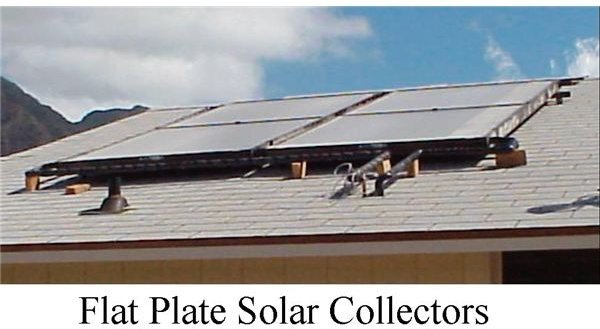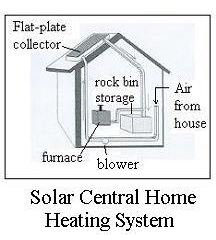An Active Solar Heating System can be a Solar Central Home Heating System
The Components of a Solar Central Home Heating System
The components needed for any solar heating system are an aperture, absorber, heat storage mass, distribution system, controls, and backup heating system. For information on how these components are used in passive solar heating see, “Principles of Passive Solar Heating Systems and How They Work.” This article will be about active solar heating systems, which use pumps, fans, and/or blowers to move fluid around in the heating system.
Solar collectors, typically mounted on the roof of a home with an active solar central home heating system, contain the aperture and absorber. The aperture is the glazing on the collectors through which the solar rays pass to reach the absorber, typically black painted metal, which heats air or water in the collector. The heated air or water is sent to heat the home,
and if there is excess heat it is sent to a heat storage medium (usually a bed or rocks for air solar heating systems or a tank of water for a water solar heating systems). The distribution system is typically the air handling system of a standard home furnace. A control system is needed to direct heated fluid to heat the home or to thermal storage, and to send heated fluid from the thermal storage to heat the home as needed. It is usually not economical to design a solar central home heating system to provide all of the heat needed under the worst possible conditions (a period of very cold weather and very little sunshine), so a backup heating system is needed. The backup heating system would typically be a furnace using a conventional fuel and also used as the heat distribution system. If the solar heating system provides all of the needed heat most of the time, then the backup heating system won’t consume very much fuel over a heating season.
How Much Collector Area Does My Active Solar Heating System Need?
The collector area needed for your solar central home heating system depends upon the heat loss rate from your home; climate information about the location of the home (specifically heating-degree days - preferably by month); and information about the rate of

incoming solar radiation (solar insolation) at the home’s location. See the article, “Estimation of Heat Loss/Heating Needs from Your Utility Bills,” for a description of a method and example calculation of the first factor, the heat loss rate from the home. The article, “Heating Degree Days for Passive Solar Heating Systems in the U.S.,” has information about heating degree days as a measure of climate based heating requirements and a source for heating degree day data for 239 U.S. cities. The article, “Estimating Solar Radiation Rate to the Tilted Surface of a Solar Panel in the U.S.,” has information about a free source of U.S. solar data that can be used to find the average monthly rate of solar radiation striking a solar collector at several standard tilt angles. The maximum solar radiation in the winter time is captured by a solar collector tilted at an angle from the horizontal approximately equal to the local latitude angle +15o (in the northern hemisphere), so that would be a suitable tilt angle for the solar collectors of a solar central home heating system.
Example Calculation of Solar Collector Area
Problem Statement - Part 1: Consider a 2000 sq. ft. house in Albuquerque, NM. It has been determined using the methods from the articles mentioned above, that the heat loss rate from the house is 5.6 Btu/oF-day-ft2 and that there are an average of 955 oF-day heating degree days in January in Albuquerque. How many Btu/day are needed on the average to heat this house in the month of January?
Solution: The total heat needed for the month of January is: (5.6 Btu/oF-day-ft2)(2000 ft2)(955 oF-days) = 10,696,000 Btu. Dividing by the 31 days in January gives: 345,032 Btu/day as the average needed for heat in January.
Problem Statement - Part 2: Approximately how many square feet of south facing, flat plate solar collector, at a tilt angle of 50o from the horizontal, would be needed to provide the 345,032 Btu/day of heat to the home in Albuquerque, NM.
Solution: From the first reference below (discussed in some detail in the “Estimating Solar Radiation Rate …” article mentioned above), it is noted that the latitude of Albuquerque, NM, is 35.05 oN, so the given 50o tilt angle is approximately equal to the latitude plus 15o. Also, from the same reference, it can be found that the solar radiation rate to a south facing, flat plate solar collector tilted at latitude plus 15o from the horizontal is: 5.8 kWh/day/m2 (1840 Btu/day/ft2). The 1840 Btu/day/ft2, however, is the rate of solar radiation striking the collector. The fraction of that figure that will be delivered as useful heat to the house is the efficiency of the solar collector. From the second reference below, typical efficiency for a flat plate solar collector could range from 30 to 70%, depending on many factors. Assuming 50% collector efficiency, the collector area needed is: (345,032 Btu/day)/[(0.50)(1840) Btu/day/ft2] = 375 ft****2.
What about Heat Storage for my Active Solar Heating System?
The solar collector area calculated in the previous section should provide the needed heat for the home in an average January. For a colder than average January, the backup heating system would be needed part of the time. Even for an average or warmer than average January, however, the heat would all be coming in during daylight hours when the sun is shining, and heat is also needed at night and during cloudy periods. A heat storage medium would be needed to collect and store excess heat and release it when needed, as shown in the diagram above. Information about the average hours of sunshine per day could be used to estimate what fraction of the total heat delivered by the solar collector will need to be stored for later use.
References
1. Solar Radiation Data Manual for Flat-Plate and Concentrating Collectors (Provides solar radiation values for common flat-plate and concentrating collectors for 239 stations in the U.S.) https://rredc.nrel.gov/solar/pubs/redbook/
2. Information on solar collector efficiencies: https://www.solarserver.de/wissen/sonnenkollektoren-e.html
3. Image of flat plate solar collector: https://www.cdc.gov/nceh/publications/books/housing/cha13.htm
